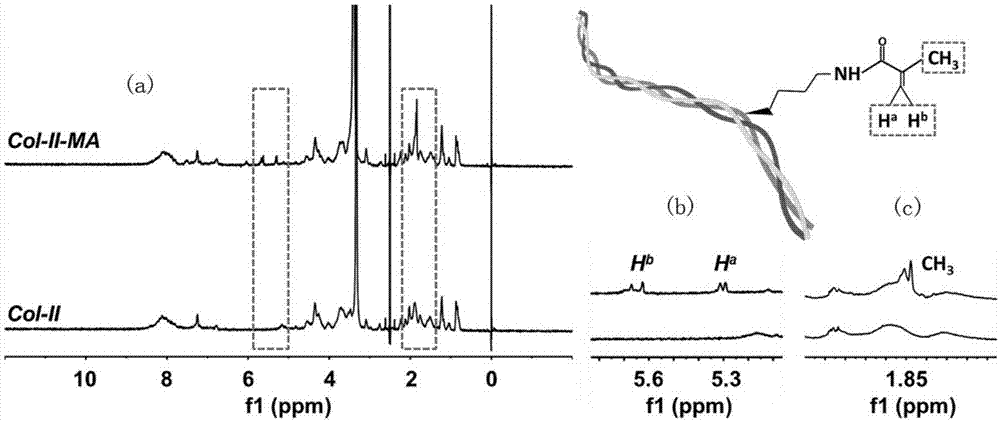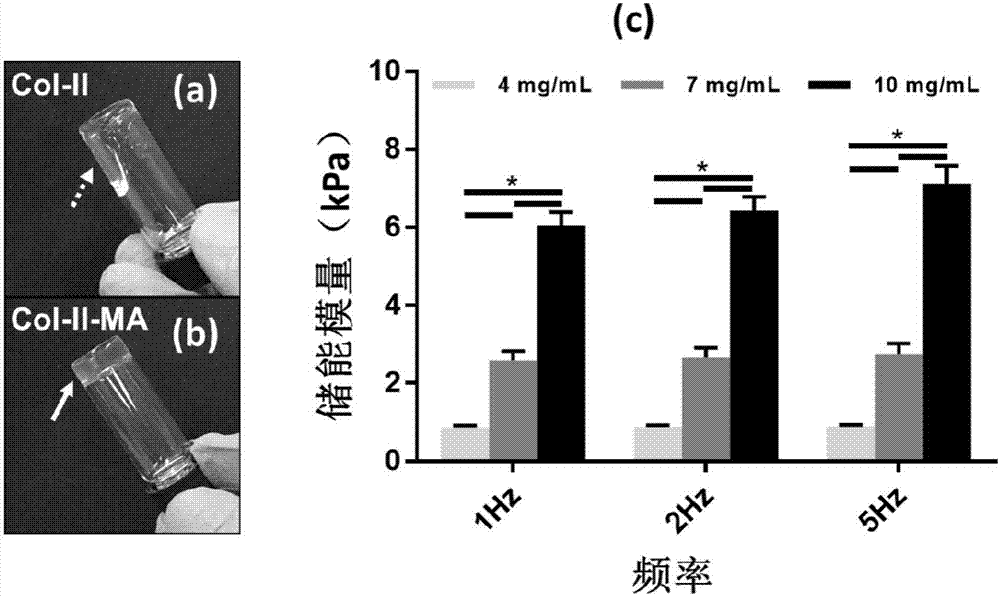Method for preparing collagen-II aquagel for inducing chondrogenic differentiation of stem cells
A collagen hydrogel and cartilage-forming technology, which is applied in the field of biomedical materials, can solve the problems that cells cannot provide a suitable environment for growth and differentiation, the sponge structure lacks three-dimensional cartilage microenvironment bionics, and the important role of type II collagen is not enough to highlight the important role of collagen, etc. Achieve good cytocompatibility, promote chondrogenic differentiation, and non-toxic raw materials
- Summary
- Abstract
- Description
- Claims
- Application Information
AI Technical Summary
Problems solved by technology
Method used
Image
Examples
Embodiment 1
[0037] The steps of this embodiment are as follows:
[0038] (1) Preparation of type II collagen solution
[0039] Under the condition of normal pressure and 4°C, the type II collagen was prepared into a type II collagen solution with a concentration of 2 mg / mL with 20 mM hydrochloric acid solution, and stirred for 12 hours to dissolve the II collagen.
[0040] (2) Synthesis of photocrosslinkable type II collagen
[0041] At normal pressure at 4°C, use 0.2M disodium hydrogen phosphate buffer and 5M sodium hydroxide solution to adjust the pH value of the type II collagen solution to 7.5, and then adjust the molar ratio of amino groups to methacrylic anhydride in the collagen to be 1 : 5, add methacrylic anhydride to the type II collagen solution after the pH value adjustment, continue to stir and react for 4 hours, supplement 5M sodium hydroxide solution in the reaction process to keep the pH value of the reaction system at 7.5.
[0042] After the reaction is finished, remove...
Embodiment 2
[0047] The steps of this embodiment are as follows:
[0048] (1) Preparation of type II collagen solution
[0049] Under the condition of normal pressure and 0°C, the type II collagen was prepared into a type II collagen solution with a concentration of 3 mg / mL with 20 mM acetic acid solution, and stirred for 12 hours to dissolve the II collagen.
[0050] (2) Synthesis of photocrosslinkable type II collagen
[0051] Under normal pressure at 0°C, use 0.5M sodium dihydrogen phosphate buffer and 3M sodium hydroxide solution to adjust the pH value of the type II collagen solution to 8, and then adjust the molar ratio of amino groups to methacrylic anhydride in the collagen to be 1 : 2.5, add methacrylic anhydride to the type II collagen solution after the pH value adjustment, continue to stir and react for 8 hours, supplement 3M sodium hydroxide solution in the reaction process to keep the pH value of the reaction system at 8.
[0052] After the reaction is finished, remove unre...
Embodiment 3
[0057] The steps of this embodiment are as follows:
[0058] (1) Preparation of type II collagen solution
[0059] Under the condition of normal pressure and 4°C, the type II collagen was prepared into a type II collagen solution with a concentration of 4 mg / mL with 100 mM hydrochloric acid solution, and stirred for 12 hours to dissolve the II collagen.
[0060] (2) Synthesis of photocrosslinkable type II collagen
[0061] Under normal pressure at 4°C, adjust the pH value of the type II collagen solution to 7.5 with 1M disodium hydrogen phosphate buffer solution and 1M sodium hydroxide solution, and then according to the molar ratio of amino group and methacrylic anhydride in the collagen is 1: 0.5, add methacrylic anhydride to the pH-adjusted type II collagen solution, and continue to stir for 12 hours. During the reaction, add 1M sodium hydroxide solution to keep the pH of the reaction system at 7.5.
[0062]After the reaction is finished, remove unreacted methacrylic anhy...
PUM
| Property | Measurement | Unit |
|---|---|---|
| storage modulus | aaaaa | aaaaa |
| storage modulus | aaaaa | aaaaa |
| storage modulus | aaaaa | aaaaa |
Abstract
Description
Claims
Application Information
 Login to View More
Login to View More - R&D
- Intellectual Property
- Life Sciences
- Materials
- Tech Scout
- Unparalleled Data Quality
- Higher Quality Content
- 60% Fewer Hallucinations
Browse by: Latest US Patents, China's latest patents, Technical Efficacy Thesaurus, Application Domain, Technology Topic, Popular Technical Reports.
© 2025 PatSnap. All rights reserved.Legal|Privacy policy|Modern Slavery Act Transparency Statement|Sitemap|About US| Contact US: help@patsnap.com



